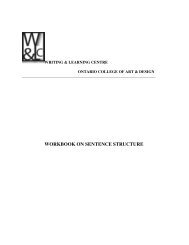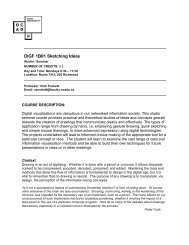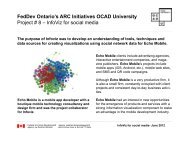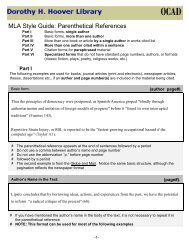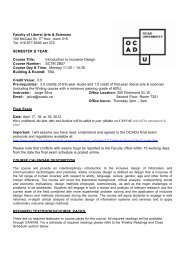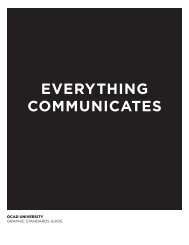institution of colonized critique: 08 kent monkman's critical ... - OCAD
institution of colonized critique: 08 kent monkman's critical ... - OCAD
institution of colonized critique: 08 kent monkman's critical ... - OCAD
You also want an ePaper? Increase the reach of your titles
YUMPU automatically turns print PDFs into web optimized ePapers that Google loves.
<strong>08</strong><br />
GEORGE A. REID AWARD 2007/<strong>08</strong> (300/400 LEVEL)<br />
ERIN McLEOD<br />
BY SUBVERTING CONSTRUCTIONS <strong>of</strong> exclusion in modern art<br />
and its history within the museum context, contemporary Aboriginal<br />
artists are repatriating more than the stolen objects <strong>of</strong> their cultures;<br />
they’re reaffirming their cultural identities by way <strong>of</strong> entirely fresh assertions.<br />
Painter, performance, installation, and multi-media artist Kent<br />
Monkman, <strong>of</strong> both Cree and Irish/English heritage, addresses the<br />
space <strong>of</strong> the postcolonial and imposes his (exaggerated) native cultural<br />
identities, still excluded in contemporary society by the very nature<br />
<strong>of</strong> the term. It is his fascination with the western European construction/destruction<br />
<strong>of</strong> indigenous culture and his reclamation <strong>of</strong> this (hybridized)<br />
identity that enables Monkman to declare additional spaces<br />
parallel to that <strong>of</strong> postcolonialism, while aggressively critiquing not<br />
only the <strong>institution</strong>, but simultaneously addressing the <strong>institution</strong> <strong>of</strong><br />
<strong>critique</strong>.<br />
THE SELF-REFLEXIVITY OF MODERN<br />
ART, THOUGH INTRINSICALLY<br />
CRITICAL, EXCLUDED OTHER<br />
ART-MAKING PRACTICES<br />
AS VITAL AND RELEVANT.<br />
equalizer for emasculated peoples, as well as the celebratory<br />
figurehead <strong>of</strong> queer culture. Here he/she is<br />
no pure and noble savage, but rather he/she is a composite<br />
<strong>of</strong> inverted stereotypes, a fantastical pop and<br />
queer culture Native diva. He/She is Jean Baudrillard’s<br />
consummate embodiment <strong>of</strong> the hyperreal. 1<br />
And he/she is running loose in the museum!<br />
Andrea Fraser’s essay “From the Critique <strong>of</strong> the<br />
Institution to an Institution <strong>of</strong> Critique” discusses an<br />
“essential feature <strong>of</strong> modernism (being) to <strong>critique</strong><br />
itself from within,” whereby the artist is positioned<br />
as the antagonist. 2 The self-reflexivity <strong>of</strong> modern<br />
art, though intrinsically <strong>critical</strong>, excluded other artmaking<br />
practices as vital and relevant, as well as artists<br />
working outside the eligibility <strong>of</strong> the artist-as-<br />
genius western model. As the postcolonial<br />
environment evolved concurrently with<br />
the postmodern art era, contemporary artists<br />
<strong>of</strong> varying marginalized places emerged<br />
with their own qualifications <strong>of</strong> admittance<br />
into the museum, by dismissing those art<br />
practices that excluded them. However, indigenous<br />
artists still contend with cultural<br />
colonizing, as those very depictions are still<br />
valued for their historical significance. Even<br />
in an environment that functions as postcolonial<br />
to everyone else, the “post-Indian” 3<br />
era has only just begun, and remains intrinsically<br />
bound to its <strong>colonized</strong> past.<br />
Repatriation is an arduous, sensitive process<br />
within the museological community,<br />
who can be understandably (though not so<br />
justifiably) hesitant to part with valuable objects,<br />
and with valuable contexts <strong>of</strong> history.<br />
2 Andrea Fraser,<br />
“From the Critique<br />
<strong>of</strong> the Institution<br />
to an Institution <strong>of</strong><br />
Critique,” Institutional<br />
Critique and<br />
After, Ed. John<br />
Welchman. (Zurich:<br />
JRP/Ringier,<br />
2006). 126–127.<br />
3 David McIntosh,<br />
“Kent Monkman’s<br />
Postindian Diva<br />
Warrior: From<br />
Simulacral Historian<br />
to Embodied<br />
Liberator,” Fuse<br />
Magazine. 29. 3.<br />
(2006) 13.<br />
INSTITUTION OF COLONIZED CRITIQUE:<br />
Monkman’s brilliance is realized through the seductive nature<br />
<strong>of</strong> his work, and by a new means <strong>of</strong> valuation within the art <strong>institution</strong><br />
(through playfully vicious slings at the old). Monkman’s sadomasochistic<br />
alter-ego Miss Chief Eagle Testickle becomes the unlikely<br />
KENT MONKMAN’S CRITICAL<br />
HYBRIDITY<br />
1 “Simulation is no longer that <strong>of</strong> a territory, a referential being<br />
or a substance. It is the generation by models <strong>of</strong> a real without<br />
origin or reality: a hyperreal.” Jean Baudrillard, “The Precession<br />
<strong>of</strong> Simulacrae,” A Post Modern Reader, Eds. Joseph P. Natoli,<br />
Linda Hutcheon, (New York: SUNY Press, 1993) 2.<br />
56 INSTITUTION OF COLONIZED CRITIQUE:<br />
KENT MONKMAN’S CRITICAL HYBRIDITY LINE BREAK 57
58<br />
These contexts have maintained <strong>institution</strong>al<br />
authority. Monkman takes the most subversive<br />
advantage <strong>of</strong> these contexts where<br />
their values still permeate. Within the museum,<br />
Monkman exposes the authoritative<br />
structure for what it is and has long been: a<br />
constructed narrative that is not at all a politically<br />
neutral space. For Monkman the <strong>critique</strong><br />
is, just as Fraser suggests, “historically<br />
bound in the conceptual social field.” 4<br />
4 Fraser, “From the Critique <strong>of</strong> the Institution to an<br />
Institution <strong>of</strong> Critique.” 128.<br />
5 Paul Kane (1810–1871) was a famous artist/explorer<br />
who documented the “vanishing races” <strong>of</strong> First<br />
Nations peoples in the 19th C, but very much through<br />
the lens <strong>of</strong> European master painting, <strong>of</strong>ten dressing<br />
up his subjects in inauthentic finery and staging “authentic”<br />
scenes for ethnographic/historical posterity.<br />
“Paul Kane about” The Art <strong>of</strong> Paul Kane. 2007. Cine-<br />
Focus Canada Inc. 21 January, 20<strong>08</strong>, 10 April, 20<strong>08</strong>.<br />
<br />
6 George Catlin (1796–1872) was a showman and<br />
entrepreneur who also specialized in portraits <strong>of</strong> First<br />
Nations peoples and wrote and lectured extensively<br />
about the “primitive” cultures he encountered in his<br />
many travels throughout North America.<br />
“George Catlin and his Indian Gallery,” Smithsonian<br />
American Art Museum, Smithsonian Institute. 21<br />
January, 20<strong>08</strong>, 10 April, 20<strong>08</strong>. .<br />
The outright exclusion <strong>of</strong> aboriginal artists within<br />
the museum and the very particular framing <strong>of</strong> objects<br />
as ethnographical and anthropological specimens<br />
only spurs on Monkman’s attack <strong>of</strong> the likes<br />
<strong>of</strong> Paul Kane 5 and George Catlin 6 as major bases <strong>of</strong><br />
protest. Yet Monkman is an exceptional painter in<br />
his own right, and clearly lovingly labours over the<br />
sublime landscapes and explicitly detailed depictions<br />
<strong>of</strong> cowboys and Indians at play (and consensual punishment).<br />
This becomes clear in Portrait <strong>of</strong> the Artist<br />
as Hunter (2002), referencing Kane’s Buffalo chase<br />
paintings <strong>of</strong> the late 1800s. Here epic clouds swoosh<br />
across a vast prairie, with rising foothills and mountains<br />
behind. Miss Chief rides bareback, an insanely<br />
long headdress and pink chest plate adorn his/her<br />
perfect physique, as he/she points an arrow at a bareassed<br />
cowboy riding just ahead…or is it that buffalo<br />
singled out just ahead that he/she points to? This<br />
appears to be answered in the small acrylic painting<br />
Heaven and Earth (2001) as a quizzical buffalo stands<br />
to the left <strong>of</strong> the prairie scene, bleeding from spear<br />
wounds in his haunches, as a virile young Indian<br />
mounts an eager cowboy, pants down, bound, and<br />
on his knees. Miss Chief reinvents Kane’s construct<br />
<strong>of</strong> authenticity, by confusing sexual conventions and<br />
literally deflowering the notion <strong>of</strong> the hetero cowboy<br />
and noble Indian.<br />
MISS CHIEF REINVENTS<br />
KANE’S CONSTRUCT OF<br />
AUTHENTICITY, BY<br />
CONFUSING SEXUAL CONVENTIONS<br />
AND LITERALLY DEFLOWERING<br />
THE NOTION OF THE HETERO<br />
COWBOY AND NOBLE<br />
INDIAN.<br />
INSTITUTION OF COLONIZED CRITIQUE: KENT MONKMAN’S CRITICAL HYBRIDITY<br />
AMAZINGLY, MONKMAN SUBVERTS ALL OF THESE<br />
TENETS AS HIS MAJOR STRATEGIES OF HYBRIDITY<br />
AND CRITIQUE.<br />
Isabelle Graw suggests a “duality <strong>of</strong> assumption<br />
and context” in the practice <strong>of</strong> <strong>institution</strong>al <strong>critique</strong>. 7<br />
Monkman’s reinterpretation <strong>of</strong> value should be, and<br />
is, alarming within the museum context because it<br />
challenges an authoritative cultural standard. However,<br />
the contemporary climate is a place for seemingly<br />
constant recontextualization <strong>of</strong> histories. Just<br />
as Kane and Catlin imagined their respective contexts,<br />
Monkman reminds us that theirs are but one<br />
narrow utterance in what should be a choir <strong>of</strong> historical<br />
and cultural representation.<br />
In the large salon-style painting, Si je t’aime prends<br />
garde à toi (2007) (acrylic on canvas), the scene depicted<br />
is uncharacteristically tender. Instead <strong>of</strong> a<br />
rough n’ randy coupling between dominant Indian<br />
and submissive cowboy on the wild plains, here is<br />
the artist and his sculpture embracing with a passionate<br />
kiss. The red-headed white artist wears buckskin<br />
pants and moccasins and his studio is full <strong>of</strong> Native<br />
paraphernalia; the life-sized sculpture turns to reallife,<br />
hot-blooded, Native man with this kiss, naked<br />
atop his horse as a Raven/cupid flitters above them,<br />
referencing the artist’s infatuation with the exotic<br />
Other. This beautiful creature comes to life because<br />
<strong>of</strong> the artist’s (erotic) envisaging.<br />
Throughout Monkman’s work we can see the<br />
consideration with which he weighs how drastically<br />
art practices have both conceptually and<br />
practically changed since the era <strong>of</strong> modern<br />
art. In Loretta Todd’s essay “What More<br />
Do They Want?” she makes a distinction<br />
that modernism was an era that “devalued<br />
our cultural complexities…Modernism<br />
contains the basic tenets <strong>of</strong> the Enlightenment:<br />
a hierarchy <strong>of</strong> cultures, the subduing<br />
<strong>of</strong> nature, and the supremacy <strong>of</strong> technical<br />
and scientific reason.” 8 Amazingly,<br />
Monkman subverts all <strong>of</strong> these tenets as his<br />
major strategies <strong>of</strong> hybridity and <strong>critique</strong>.<br />
Jose Munoz defines the concept: “Hybrid<br />
catches the fragmentary subject formation<br />
<strong>of</strong> people whose identities traverse different<br />
race, sexuality, and gender identifications.” 9<br />
As an artist working in what we still consider<br />
the postmodern era, Monkman addresses<br />
the narrow view <strong>of</strong> modernism, but weaves<br />
his way around that postcolonial space <strong>of</strong><br />
the postmodern that excludes his contemporary<br />
cultural identity.<br />
One <strong>of</strong> Monkman’s most obvious strategies<br />
<strong>of</strong> hybridity is his brash imposition<br />
LINE BREAK 59<br />
7 Isabelle Graw,<br />
“Beyond Institutional<br />
Critique,” Institutional<br />
Critique<br />
and After, Ed. John<br />
Welchman, (JRP/<br />
Ringier: Zurich,<br />
2006) 137.<br />
8 Loretta Todd,<br />
“What More Do<br />
They Want?”<br />
Indigena: Contemporary<br />
Native<br />
Perspectives in<br />
Canadian Art, Eds.<br />
Gerald McMaster<br />
and Lee-Ann<br />
Martin (Vancouver:<br />
Douglas and<br />
McIntyre, 1992)<br />
72.<br />
9 Kerry Swanson,<br />
“The Noble Savage<br />
Was a Drag<br />
Queen: Hybridity<br />
and Transformation<br />
in Kent Monkman’s<br />
Performance and<br />
Visual Art Interventions,”<br />
Sexualities<br />
and Politics in<br />
the Americas, 2.2<br />
(Fall 2005) Qtd. in<br />
Swanson. 2.
10 Jeremy Gilbert-<br />
Rolfe, “Beauty and<br />
the Contemporary<br />
Sublime,” Uncontrollable<br />
Beauty:<br />
Toward a New<br />
Aesthetics, Ed.<br />
Bill Beckley (New<br />
York: Allworth<br />
Press, 1998) 40.<br />
11 Kerry Swanson,<br />
“The Noble Savage<br />
Was a Drag Queen:<br />
Hybridity and Transformation<br />
in Kent<br />
Monkman’s Performance<br />
and Visual<br />
Art Interventions,”<br />
Sexualities and Politics<br />
in the Americas,<br />
2.2 (Fall 2005) Qtd.<br />
in Swanson. 2.<br />
60<br />
<strong>of</strong> queer culture into the hallowed halls <strong>of</strong><br />
modern art history. But is it imposition, or<br />
inquisition? It’s difficult in our contemporary<br />
age not to read the repressed homoerotic<br />
tensions that linger throughout 19th<br />
century colonial painting, particularly<br />
depictions <strong>of</strong> the exotic Other as natural,<br />
savage, and animalistic. Miss Chief as the<br />
Drag-Diva impresario simply camps up<br />
what was indubitably always there. In his<br />
essay “Beauty and the Contemporary Sublime,”<br />
Jeremy Gilbert-Rolfe picks up from<br />
art historian Winckelmann’s suggestions<br />
<strong>of</strong> sublime power (in relation to beauty). He<br />
discusses the retooling <strong>of</strong> sublimity in the<br />
postmodern era:<br />
For my part I want to suggest a model in<br />
which the sublime is androgynous and<br />
beauty irreducibly feminine…not least<br />
ins<strong>of</strong>ar as the difference for me is not to<br />
be found between the active and the passive,<br />
but rather between the transitive<br />
and the intransitive. I’ll suggest that the<br />
12 “The concept <strong>of</strong> the spectacle brings together and<br />
explains a wide range <strong>of</strong> apparently disparate phenomena.<br />
Diversities and contrasts among such phenomena<br />
are the appearances <strong>of</strong> the spectacle – the<br />
appearances <strong>of</strong> a social organization <strong>of</strong> appearances<br />
that needs to be grasped in its general truth…that<br />
has invented a visual form for itself.” Guy Debord, The<br />
Society <strong>of</strong> the Spectacle, (New York: Zone Books,<br />
1995) 10.<br />
IT IS AS IF MONKMAN SEES<br />
THE MUSEUM AS HIS OWN SUBLIME<br />
LANDSCAPE TO BE<br />
CONQUERED.<br />
sublime is nowadays a technological sublime—a<br />
product <strong>of</strong> reason that is out <strong>of</strong> control and has in<br />
practice replaced its own ground with one <strong>of</strong> its<br />
own making. 10<br />
Miss Chief Eagle Testickle embodies these very<br />
notions <strong>of</strong> the new sublime. He/she prances around<br />
the stuffiness <strong>of</strong> bureaucratic authority and divines a<br />
fresh perspective on authoritative history (or histories),<br />
all the while liberating the very thing he/she<br />
mocks from his/her sexually ambiguous perspective<br />
that had been left repressed in modern art history.<br />
The concept <strong>of</strong> hybridity infuses Miss Chief with<br />
his/her transformative power, especially within the<br />
<strong>institution</strong>, a meaningful site for intervention. He/<br />
She conjures First Nations archetypes <strong>of</strong> the Trickster<br />
and the Two-Spirited—someone who is both<br />
male and female at once. This state <strong>of</strong> being was accepted<br />
practice until its oppression via colonization<br />
and the introduction <strong>of</strong> Christianity to First Nations<br />
cultures. 11<br />
Charlotte Townsend-Gault’s mention <strong>of</strong> Debord’s<br />
concept <strong>of</strong> the spectacle 12 suggests an unintentional<br />
assertion <strong>of</strong> cultural identity by the artist Bill Reid in<br />
the 1950s and 60s, begging the question in snooty<br />
INSTITUTION OF COLONIZED CRITIQUE: KENT MONKMAN’S CRITICAL HYBRIDITY<br />
modern art circles, “who may speak with authority?”<br />
13 She goes on to call “hybridizing tendencies”<br />
and “strategic essentialism” <strong>of</strong> Native art (<strong>of</strong> the<br />
modern era) as giving an authority and ownership<br />
to Native artists, and to their culture and practices. 14<br />
While Monkman’s Cree ancestry allows him a different<br />
<strong>critical</strong> voice <strong>of</strong> authority, his mixed Cree/Irish<br />
heritage adds yet another intriguing dimension to<br />
his hybrid approach. The viewer need not necessarily<br />
understand <strong>institution</strong>al ideology to get the joke<br />
however, although anyone growing up in the Canadian<br />
school system is well aware <strong>of</strong> the iconic place<br />
the Group <strong>of</strong> Seven still inhabits as Canada’s first art.<br />
Yet Miss Chief satirically flips this construction;<br />
it is the <strong>institution</strong> that is marginalized, minimized<br />
and put in its naughty little place. It is as if Monkman<br />
sees the museum as his own sublime landscape to be<br />
conquered.<br />
Monkman’s recent exhibition at the Museum <strong>of</strong><br />
Contemporary Canadian Art (MOCCA), The Triumph<br />
<strong>of</strong> Mischief in collaboration with the Art Galleries<br />
<strong>of</strong> Hamilton and Greater Victoria, reflects the<br />
culmination <strong>of</strong> his hybridizing strategies as a multimedia<br />
call for <strong>institution</strong>al and historical accountability.<br />
THE VIEWER IS FOREVER<br />
ENCOUNTERING THE CONTEXTUAL<br />
CLASHES OF THE MODERN<br />
AND THE POSTMODERN,<br />
IN BOTH MEDIUM AND<br />
MESSAGE<br />
AT ONCE.<br />
What makes Monkman so accessible,<br />
beyond the enticing audacity <strong>of</strong> his narratives,<br />
is his ability to speak from multiple<br />
perspectives at once, through both subversion<br />
<strong>of</strong> subject/object as well as literal<br />
variety in medium and media. As much<br />
as his paintings speak (albeit explicitly) to<br />
the traditionally labour-intensive honing<br />
<strong>of</strong> one’s innate modern era talents, Monkman’s<br />
multi-media approach constitutes<br />
another decisive strategy <strong>of</strong> <strong>critique</strong>. Monkman<br />
is a painter, performer, a filmmaker, a<br />
photographer, and an installation artist. He<br />
is also an illustrator, costume designer, and<br />
set designer with seemingly equal prowess.<br />
Comfortably melding contemporary<br />
art practices, Monkman toys with the static<br />
notions <strong>of</strong> modernity still infiltrating the<br />
<strong>institution</strong>al space and literally layers in his<br />
contemporary multi-view <strong>critique</strong>s. The<br />
use <strong>of</strong> repetitive themes (with Miss Chief<br />
taking top billing) through varying visual<br />
perspectives and media enforces Monkman’s<br />
viewpoints, in tandem with his strategy<br />
<strong>of</strong> spectacle and humour. The viewer is<br />
forever encountering the contextual clashes<br />
LINE BREAK 61<br />
13 Charlotte<br />
Townsend-Gault,<br />
“Struggles with<br />
Aboriginality/Modernity,”<br />
Bill Reid<br />
and Beyond:<br />
Expanding on<br />
Modern Native Art,<br />
Eds. Karen Duffek<br />
and Charlotte<br />
Townsend-Gault,<br />
(Seattle: University<br />
<strong>of</strong> Washington<br />
Press, 2004) 229.<br />
14 Townsend-Gault:<br />
230.
15 “Edward Sheriff<br />
Curtis,” Edward S.<br />
Curtis Gallery, 21<br />
November, 2003,<br />
10 April, 20<strong>08</strong>.<br />
<br />
16 Gerald<br />
McMaster, “The<br />
Double Entendre<br />
<strong>of</strong> Re-enactment,”<br />
(Toronto: V-Tape,<br />
2007) 21.<br />
17 Jane Wark,<br />
“Dressed to Thrill:<br />
Costume, Body,<br />
and Dress in Canadian<br />
Performative<br />
Art,” Caught in the<br />
Act: an anthology<br />
<strong>of</strong> performance<br />
art by Canadian<br />
Women, Eds. Tanya<br />
Mars and Johanna<br />
Householder<br />
(Toronto: YYZ<br />
Books, 2005). Qtd.<br />
in Wark. 94.<br />
18 McMaster: 22.<br />
19 Isabelle Graw,<br />
“Beyond Institutional<br />
Critique,”<br />
Institutional Critique<br />
and After, Ed. John<br />
Welchman, (Zurich:<br />
JRP/Ringier,<br />
2006) 141.<br />
62<br />
<strong>of</strong> the modern and the postmodern, in both<br />
medium and message at once.<br />
Yet it is extreme humour, in parody and<br />
satire that allows Monkman to make his<br />
most poignant points, as seen in the Taxonomy<br />
<strong>of</strong> the European Male, a film series projected<br />
onto a bearskin rug that recounts the<br />
ethno-erotic behaviours <strong>of</strong> the endangered<br />
European white male. Surrounded by a crystal<br />
chandelier tipi altogether entitled Théâtre<br />
de Cristal (2007), the mood is set for boy-toy<br />
romance. His most recent short (silent) film,<br />
Shooting Geronimo (2007), uses the aesthetic<br />
<strong>of</strong> Edward Curtis 15 photographs in black<br />
and white, and is a “double take on shooting,<br />
first as a filmic event then as an accidental<br />
incident,” 16 as Miss Chief, giggling, looks<br />
on. Another painting <strong>of</strong> the MOCCA exhibit<br />
has Miss Chief in full pink diva regalia atop a<br />
sleigh mushing a team <strong>of</strong> primped up poodles<br />
and assorted yappy lap dogs, set against<br />
a pristine Canadian winterscape.<br />
In her essay “Dressed to Thrill: Costume,<br />
Body, and Dress in Canadian Performative<br />
Art,” Jane Wark discusses parody in particular<br />
as a strategy that Linda Hutcheon<br />
describes as “undermining the Romantic<br />
fallacy <strong>of</strong> originality,” thus exposing the relationships<br />
between the “social agents” <strong>of</strong><br />
the original and the Other. 17 Monkman uses parody<br />
to expose the limits <strong>of</strong> the authoritative socio-economic<br />
structure and here Fraser suggests can be the<br />
site <strong>of</strong> counter-culture. 18 Miss Chief performed a séance<br />
at the Royal Ontario museum in October 2007,<br />
conjuring the spirits <strong>of</strong> both Kane and Catlin, including<br />
multiple costume changes, <strong>of</strong> course.<br />
Gerald McMaster, in his interactive essay “The<br />
Double Entendre <strong>of</strong> Re-Enactment,” pinpoints the<br />
potential risk <strong>of</strong> Monkman’s approach to the <strong>critique</strong><br />
<strong>of</strong> the <strong>institution</strong> when he says:<br />
For contemporary Native American and Canadian<br />
artists… the difficulty in re-enacting the<br />
stereotype hinges on the absurd degree to which<br />
they acutely address—through the strategy <strong>of</strong> humour—something<br />
that is almost completely lacking<br />
in the works <strong>of</strong> non-Natives. 19<br />
MONKMAN USES PARODY<br />
TO EXPOSE THE LIMITS OF<br />
THE AUTHORITATIVE<br />
SOCIO-ECONOMIC<br />
STRUCTURE.<br />
INSTITUTION OF COLONIZED CRITIQUE: KENT MONKMAN’S CRITICAL HYBRIDITY<br />
MONKMAN’S MASOCHISTIC<br />
MIMICRY BELIES THE THOUGHTFULNESS<br />
Here again, the space <strong>of</strong> hybridity that runs parallel<br />
to the postcolonial leaves open the opportunities<br />
for Aboriginal artists to explore and repatriate that<br />
experience <strong>of</strong> historical otherness. Graw also implies<br />
a potential warning, in her investigation into the<br />
“paradoxical construction” <strong>of</strong> Institutional Critique:<br />
The double scene <strong>of</strong> this <strong>critique</strong> reminds us <strong>of</strong> two<br />
things—<strong>of</strong> the deep entanglement between artists<br />
and <strong>institution</strong> and <strong>of</strong> the degree to which <strong>institution</strong>s<br />
have determined the shape or direction <strong>of</strong><br />
works especially made for or about them. 20<br />
Monkman’s approach however, regardless <strong>of</strong><br />
whatever consenting <strong>institution</strong> it attacks, <strong>of</strong>fers<br />
another level <strong>of</strong> narrative, as David McIntosh states,<br />
that “cuts across simulated histories and the subject/<br />
object differences that construct the coloured gaze’s<br />
fetish facticity.” 21 He suggests that Monkman, as<br />
much as Paul Kane by their nature <strong>of</strong> being artists,<br />
are each “subjective hunters.” 22<br />
OF HIS ARTISTIC EXECUTION.<br />
Monkman’s masochistic mimicry belies<br />
the thoughtfulness <strong>of</strong> his artistic execution;<br />
however it drives home the implicit frustration<br />
<strong>of</strong> generations <strong>of</strong> Aboriginal artists with<br />
the <strong>institution</strong>’s part in this stereotype construct.<br />
Every Monkman piece is humourous<br />
or tongue-in-cheek to some degree, and<br />
this makes for more palatability for viewers.<br />
Monkman considers his contemporary audience,<br />
always, and fun is to be had, always,<br />
at the expense <strong>of</strong> those long dead, but also<br />
<strong>of</strong> those environments that today exist to<br />
serve an increasingly diverse public and<br />
therefore must be increasingly accountable.<br />
Hence he is continually welcomed into the<br />
<strong>institution</strong>al space.<br />
As Monkman continues to challenge the<br />
<strong>institution</strong> that houses a history he is set to<br />
open up, he also refreshes that history—<br />
albeit as now only one <strong>of</strong> any number <strong>of</strong><br />
potential histories—by the very act <strong>of</strong> addressing<br />
it. Yet Monkman’s imagery, though<br />
no more outrageous, one might say, than<br />
what the <strong>institution</strong> has portrayed as an authoritative<br />
voice over a marginalized and,<br />
LINE BREAK 63<br />
20 Isabelle Graw,<br />
“Beyond Institutional<br />
Critique,”<br />
Institutional Critique<br />
and After, Ed. John<br />
Welchman, (Zurich:<br />
JRP/Ringier, 2006)<br />
141.<br />
21 David McIntosh,<br />
“Kent Monkman’s<br />
Postindian Diva<br />
Warrior: From Simulacral<br />
Historian to<br />
Embodied Liberator,”<br />
Fuse Magazine.<br />
29. 3. (2006) 18.<br />
22 McIntosh: 18.
64<br />
until recently, voiceless culture (within<br />
the museum environment), Monkman’s<br />
imagery is still so graphic, still so explicit,<br />
it is not something one would want their<br />
grandmother to stumble across in the Canadiana<br />
section <strong>of</strong> their local art <strong>institution</strong>.<br />
Or…would one? It will be interesting to see<br />
how Monkman’s works, especially his luscious<br />
salon-style paintings, hold up over<br />
the years. While they may always work in<br />
tandem with the depictions by Kane, Catlin,<br />
et al. as ulterior histories that have awaited<br />
mainstream consideration for almost 200<br />
years, will they lose their impact as Kane<br />
and Catlin fade deeper into postcolonial<br />
disfavour? There is so much more to Monkman’s<br />
body <strong>of</strong> work than to imply it depends<br />
solely upon these colonial references<br />
to be sustained; there are many layers <strong>of</strong><br />
consideration beyond simply this historical<br />
commentary. But at the same time, the issue<br />
<strong>of</strong> cultural colonization remains frighteningly<br />
relevant. Cultures around the world<br />
continue to suffer eerily similar injustices.<br />
Monkman’s subversion <strong>of</strong> the rape <strong>of</strong> a culture<br />
demands an explicit representation, especially<br />
at ground zero <strong>of</strong> cultural authority:<br />
MONKMAN’S SUBVERSION<br />
OF THE RAPE OF A CULTURE DEMANDS<br />
AN EXPLICIT<br />
REPRESENTATION.<br />
the art <strong>institution</strong>. As campy as Miss Chief and his/<br />
her world <strong>of</strong> the hyperreal may be, the coping mechanisms<br />
<strong>of</strong> humour and spectacle are valid responses<br />
to an equally ridiculous era in North America <strong>of</strong> the<br />
repression <strong>of</strong> cultural identity and oppression <strong>of</strong><br />
rightful indigenous practices. <br />
BIBLIOGRAPHY<br />
Baudrillard, Jean , “The Precession <strong>of</strong> Simulacrae,”<br />
A Post Modern Reader, Ed. Joseph P. Natoli, Linda<br />
Hutcheon. New York: SUNY Press, 1993.<br />
Debord, Guy, The Society <strong>of</strong> the Spectacle, New York:<br />
Zone Books, published in 1967, reprinted in 1992.<br />
“Edward Sheriff Curtis,” Edward S. Curtis Gallery, 21<br />
November, 2003, 10 April, 20<strong>08</strong>. .<br />
Fraser, Andrea, “From the Critique <strong>of</strong> the Institution<br />
to an Institution <strong>of</strong> Critique,” Institutional Critique<br />
and After, Ed. John Welchman. Zurich: JRP/Ringier,<br />
2006.<br />
“George Catlin and his Indian Gallery,” Smithsonian<br />
American Art Museum, Smithsonian Institute. 21<br />
January, 20<strong>08</strong>, 10 April, 20<strong>08</strong>. .<br />
INSTITUTION OF COLONIZED CRITIQUE: KENT MONKMAN’S CRITICAL HYBRIDITY<br />
Gilbert-Rolfe, Jeremy, “Beauty and the Contemporary<br />
Sublime,” Uncontrollable Beauty: Toward a New<br />
Aesthetics, Ed. Bill Beckley. New York: Allworth<br />
Press, 1998.<br />
Graw, Isabelle, “Beyond Institutional Critique,” Institutional<br />
Critique and After, Ed. John Welchman,<br />
Zurich: JRP/Ringier, 2006.<br />
“Kent Monkman”, Cybermuse, 12 April, 20<strong>08</strong><br />
<br />
Liss, David, “Kent Monkman Miss Chief’s Return:<br />
Subverting the Canon through Sublime Landscapes<br />
and Saucy Performances,” Canadian Art, Fall 2005.<br />
McIntosh, David, “Kent Monkman’s Postindian Diva<br />
Warrior: From Simulacral Historian to Embodied<br />
Liberator,” Fuse Magazine. 29. 3. 2006.<br />
McMaster, Gerald, “The Double Entendre <strong>of</strong> Re-enactment”,<br />
Toronto: V-Tape, 2007.<br />
“Paul Kane about” The Art <strong>of</strong> Paul Kane.<br />
2007. CineFocus Canada Inc. 21 January,<br />
20<strong>08</strong>, 10 April, 20<strong>08</strong>. .<br />
Kerry Swanson, “The Noble Savage Was a<br />
Drag Queen: Hybridity and Transformation<br />
in Kent Monkman’s Performance and Visual<br />
Art Interventions,” Sexualities and Politics<br />
in the Americas, 2.2. Qtd. in Swanson.<br />
Todd, Loretta, “What More Do They Want?”<br />
Indigena: Contemporary Native Perspectives<br />
in Canadian Art. Eds. Gerald McMaster and<br />
Lee-Ann Martin. Vancouver: Douglas and<br />
McIntyre, 1992.<br />
Townsend-Gault, Charlotte, “Struggles<br />
with Aboriginality/Modernity,” Bill Reid<br />
and Beyond: Expanding on Modern Native<br />
Art, Eds. Karen Duffek and Charlotte<br />
Townsend-Gault, Seattle: University <strong>of</strong><br />
Washington Press, 2004.<br />
Wark, Jane, “Dressed to Thrill: Costume,<br />
Body, and Dress in Canadian Performative<br />
Art,” Caught in the Act: an Anthology <strong>of</strong><br />
Performance Art by Canadian Women, Eds.<br />
Tanya Mars and Johanna Householder. Toronto:<br />
YYZ Books, 2005.<br />
LINE BREAK 65




